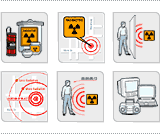 |
|
 |
 |
 |
 |
 |
 |
 |
 |
A radiation threat, commonly referred to as a "dirty bomb" or "radiological dispersion device (RDD)", is the use of common explosives to spread radioactive materials over a targeted area. It is not a nuclear blast. The force of the explosion and radioactive contamination will be more localized. While the blast will be immediately obvious, the presence of radiation will not be clearly defined until trained personnel with
specialized equipment are on the scene. As with any radiation, you want to try
to limit exposure. It is important to avoid breathing radiological dust that may be released in the air.
If There is a Radiation Threat or "Dirty Bomb"
- If you are outside and there is an explosion or authorities warn of a radiation release nearby, cover your nose and mouth and quickly go inside a building that has not been damaged. If you are already inside check to see if your building has been damaged. If your building is stable, stay where you are.

Close windows and doors; turn off air conditioners, heaters or other ventilation systems.
- If you are inside and there is an explosion near where you are or you are warned of a radiation release inside, cover nose and mouth and go outside immediately. Look for a building or other shelter that has not been damaged and quickly get inside.

Once you are inside, close windows and doors; turn off air conditioners, heaters or other ventilation systems.
- If you think you have been exposed to radiation, take off your clothes and wash as soon as possible.
- Stay where you are, watch TV, listen to the radio, or check the Internet for official news as it becomes available.
- Remember: To limit the amount of radiation you are exposed to, think about shielding, distance and time.
- Shielding: If you have a thick shield between yourself and the radioactive materials more of the radiation will be absorbed, and you will be exposed to less.
- Distance: The farther away you are away from the blast and the fallout the lower your exposure.
- Time: Minimizing time spent exposed will also reduce your risk.
|
 |
 |
 |
As with any emergency, local authorities may not be able to immediately provide information on
what is happening and what you should do. However, you should watch TV, listen to the radio,
or check the Internet often for official news and information as it becomes available. |
 |
 |
 |
For more general information, see "Are you Ready?" from Federal Emergency Management Agency. |
 |
|




